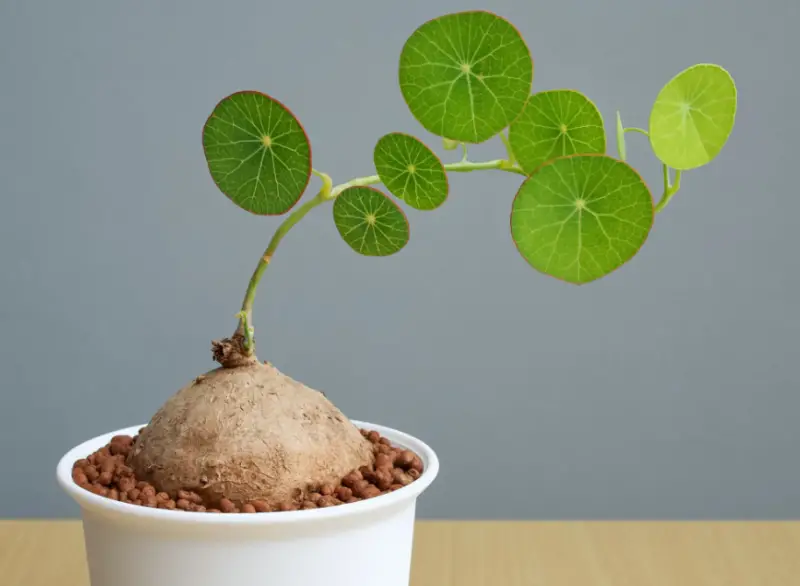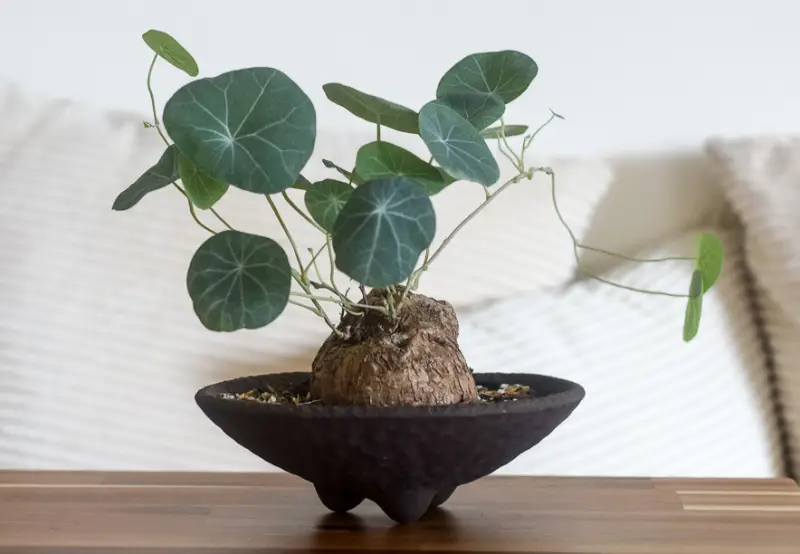Stephania erecta, often called the “potato plant” due to its tuber-like appearance, has become a favorite among plant enthusiasts around the world. Native to Southeast Asia, this unique caudiciform plant is known for its dormant caudex that, with the right care, sprouts delicate vines and shield-shaped leaves.
In this detailed guide, we will cover everything you need to know about growing and caring for Stephania erecta, from activation and care to propagation and dealing with common issues.
What is Stephania Erecta?

Origins and Characteristics
Stephania erecta is a caudiciform plant native to the forests of Thailand, Laos, Vietnam, and Cambodia. It was first described by botanist William Grant Craib in 1922 and later became known by its more common name due to the potato-like appearance of its caudex. The word “Stephania” comes from the Greek word for “crown,” referring to the plant’s crown-shaped anthers found in its flowers.
What makes this plant stand out is its caudex, a brown, potato-shaped tuber that stores water and nutrients, enabling the plant to survive dry seasons. The caudex can grow up to seven inches in diameter, and from it sprout long, slender vines adorned with white-veined, shield-shaped leaves. The leaves can grow up to two inches wide, and the vines may reach up to three feet in length.
Why Is It So Popular?
The beauty of Stephania erecta lies in its transformation. Many people are drawn to the plant’s unique growth pattern—starting as a dormant caudex and slowly sprouting into a vine-covered plant. This dramatic change, along with the anticipation of seeing it come to life, makes it a plant lover’s dream. Additionally, its simple yet elegant appearance, with vines and shield-like leaves, makes it a perfect indoor ornamental plant.
How to Grow Stephania Erecta
Preparing the Dormant Caudex for Growth
When you first acquire Stephania erecta, it is likely in its dormant state, resembling a small potato. This is completely normal, as the caudex is a storage organ that remains dormant until conditions are right for it to sprout. To “wake up” the caudex and initiate growth, follow these steps:
Soak the Caudex
Start by soaking the caudex in warm water for 24 hours. This helps hydrate the dormant plant and stimulates growth. Be sure to place the caudex with the small ring or node facing upward—this is where the shoots will emerge.
Planting
Fill a pot with well-draining soil, ideally one designed for succulents or cacti. You can add a layer of small rocks at the bottom to improve drainage. Place the caudex on top of the soil, ensuring that it is not buried, as this can lead to rot.
Creating a Humid Environment
Stephania erecta thrives in high humidity. To help the caudex sprout, create a humid environment by covering the pot with a plastic bag or using a germination dome. Water the soil until it is moist but not soaked, then loosely cover the plant to retain humidity.
Waiting for Sprouts
The sprouting process can take anywhere from two weeks to three months, depending on humidity and temperature. During this time, ensure the plant is in a warm, well-lit area with indirect sunlight.
Optimal Care for Stephania Erecta
Once your Stephania erecta has sprouted, it requires the right balance of light, water, temperature, and soil to thrive.
Lighting Needs
Stephania erecta requires bright, indirect light for about six hours a day. Direct sunlight can cause the leaves to scorch and dry out, so it’s best to place the plant a few feet away from a window or filter the light with sheer curtains. Signs that your plant is receiving enough light include large leaves and short, sturdy stems. If the stems are long and weak, the plant may be stretching for light, indicating it needs more exposure.
Watering
Watering is one of the most critical aspects of Stephania erecta care. Overwatering can lead to root rot, as the caudex stores moisture. Allow the soil to dry out completely between waterings, which typically means watering every two weeks. During its dormant phase in winter (December to April), reduce watering to once a month.
To check if your plant needs water, insert your finger about two inches into the soil—if it’s dry, it’s time to water.
Temperature and Humidity
Stephania erecta thrives in temperatures between 60-80°F (16-27°C). It also enjoys high humidity, ideally around 60-80%. To maintain humidity, mist the plant regularly, or place it in a humid environment such as a bathroom or kitchen. You can also use a humidity tray filled with pebbles and water, or place a humidifier near the plant.
Soil and Potting Mix
The key to healthy growth is using a well-draining soil mix. A cactus or succulent soil blend works well because it contains the right balance of grit, compost, and sand to allow for proper drainage. Alternatively, you can create your own mix with 50% perlite or pumice to ensure that water does not linger in the soil, preventing root rot.
Propagation of Stephania Erecta

Seed Propagation
Unlike many other houseplants that are propagated by cuttings, Stephania erecta is propagated through seeds. Here’s how you can grow new plants from seeds:
Harvesting Seeds
Stephania erecta will produce seeds within two months of growth. Once the seeds turn black and develop ridges, they are ready to be harvested. Gently pluck them off the plant for propagation.
Preparing and Planting Seeds
Soak the seeds in warm water for 24 hours to help stimulate germination. Then, plant them about 0.2 inches deep in the same type of well-draining soil used for the adult plant. Maintain a humid environment by covering the pot with a plastic bag or a small dome.
Germination and Growth
The seeds should sprout within 1-2 weeks. Once the seedlings have two leaves, you can carefully repot them into individual pots, ensuring they receive bright, indirect light and proper care as they grow.
Dealing with Common Issues
Overwatering and Root Rot
The most common issue with Stephania erecta is overwatering, which can lead to root rot. Symptoms of overwatering include yellow, wilting leaves that don’t fall off. To prevent root rot, always ensure the soil is completely dry before watering again and use a well-draining soil mix. If you suspect root rot, remove the plant from the soil, prune any affected roots, and replant in fresh soil.
Leaf Discoloration and Curling
If the leaves of your Stephania erecta are turning brown or curling, this could be a sign of too much direct sunlight. Move the plant to a location with indirect light and adjust its environment to prevent further damage.
Etiolation (Long, Weak Stems)
When Stephania erecta does not receive enough light, it may develop long, weak stems with small leaves—a process called etiolating. To fix this, move the plant to a brighter spot or use grow lights to supplement the natural light.
Pests
Although Stephania erecta is relatively pest-resistant, it can occasionally be affected by spider mites, aphids, and mealybugs. If pests are present, use a neem oil solution to treat the plant. Mix two teaspoons of neem oil and one teaspoon of dish soap in a spray bottle filled with water, and spray the plant every 5-8 days until the pests are gone.
Seasonal Care and Dormancy
Stephania erecta naturally goes dormant during the winter months, shedding its leaves as it conserves energy for the upcoming growing season. During dormancy:
- Reduce watering to once a month.
- Keep the plant in a dry, warm place.
- Increase light exposure and water as spring approaches.
Once the warmer months return, the plant will begin to sprout again, starting a new cycle of growth.
Conclusion
Stephania erecta is a fascinating and rewarding plant to grow. With its unique appearance and exciting transformation from a dormant caudex to a lush, vine-covered plant, it adds a touch of mystery and beauty to any indoor garden.
By following the care guidelines outlined in this article, you can ensure your Stephania erecta thrives and grows to its full potential. Whether you’re a seasoned plant enthusiast or a beginner, this “potato plant” is sure to captivate you with its one-of-a-kind charm.






